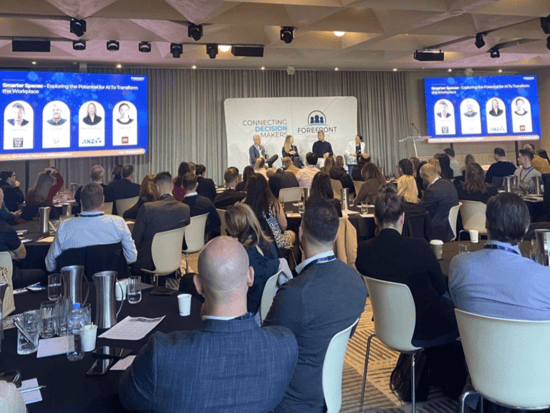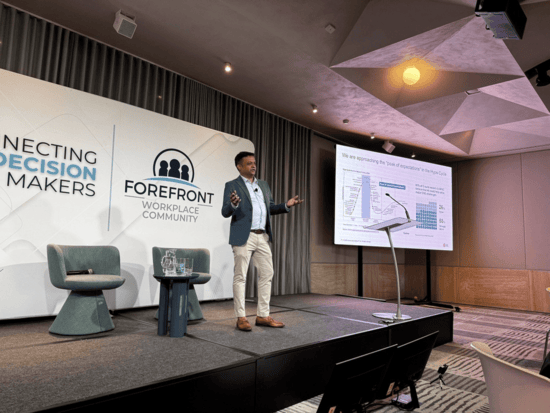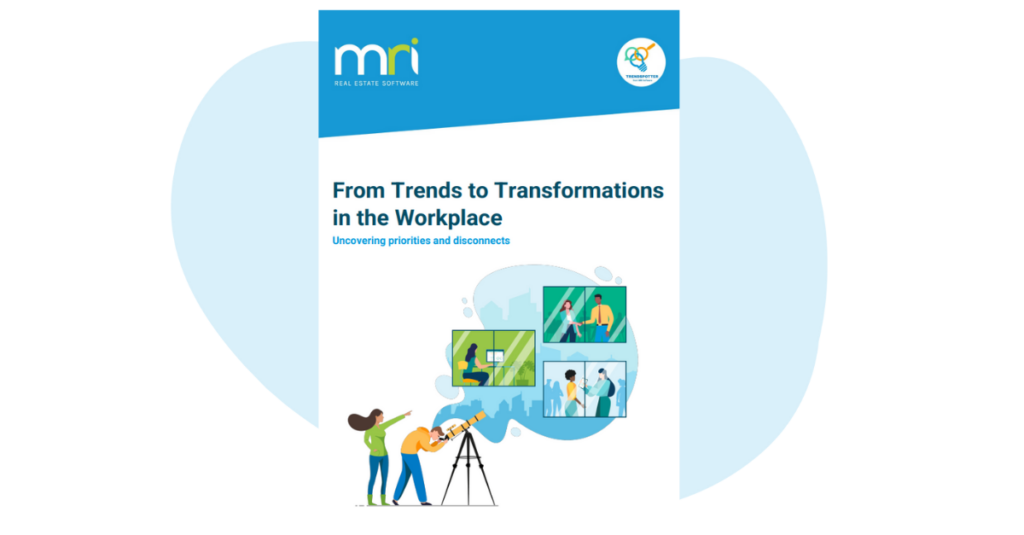Insights from the Workplace Strategy Summit 2025
The recent Workplace Strategy Summit 2025 explored pressing challenges workplace professionals face in creating and managing spaces that support today’s work practices.
A team from MRI Software joined strategists, designers, workplace experience managers and corporate real estate leaders at the Melbourne event, capturing the following insights for actionable innovation.
Panel discussion: Smarter spaces – Exploring the potential for AI in the workplace

Karen Sue, Head of Workplace Experience and Support, Coles, moderated a discussion on approaches to AI in the workplace with panel members Tim Halpin, APAC Workplace and Real Estate Lead, Block; Chen Tang, Director, Real Estate and Space Planning, Swinburne University and Sharon McDonald, Group Head of Property, ANZ.
The panel members reflected on how AI is changing the way we work. They shared their diverse approaches to using the technology to improve workplace outcomes.
Opportunities created by AI for the workplace
Tim Halpin from Block highlighted AI’s ability to address unique problems without requiring new software or consultants.
Sharon McDonald noted that ANZ has moved beyond time-consuming spreadsheet analysis to automated data processing, allowing her team to “focus on opportunities like enhancing the end-user experience” for both customers and staff.
Organisations are using AI to generate meaningful insights from occupancy patterns. Block analyses location data to identify usage trends, helping the business design more appropriate spaces. Halpin envisions voice-enabled navigation systems where visitors could simply ask, “How do I get in? Where’s my desk?” rather than reading through complex instructions.
The technology is also creating tangible business value. Block used AI to analyse global office usage patterns, identifying hours when facilities were underutilised and implementing changes that delivered measurable cost reductions.
AI implementation challenges and strategic approaches
Despite enthusiasm, implementing AI presents significant challenges. Chen Tang from Swinburne University emphasised the gap between expectations and reality: “We identified five pain points our real estate team wanted to address through AI, but realised implementation would take 3-4 years. By then, the problems might already be solved through other means.”
Sharon McDonald identified data integration as ANZ’s biggest challenge: consolidating information from leasing, facilities management, and utilisation metrics quickly enough to generate actionable insights.
Security remains a critical concern. McDonald explained that while ANZ has introduced tools like Copilot, it maintains “strict information security rules” with clear boundaries on what can be shared externally versus internally.
For budgeting, Tang recommends tying AI initiatives to projects that already have allocated funding. At Block, Halpin noted a shift toward internal development, with stakeholders increasingly asking, “Why can’t we build that ourselves?” as AI tools become more accessible.
M Moser Case study: Purpose-driven data – How it can enhance the human experience
Marcus Chan, Associate at M Moser, discussed the relationship of data, design, and human experience in modern workplaces. Based on his extensive experience with major international workplace design projects, he explored why data-driven design matters, what it can do and how to implement it effectively.
Chan described workplace transformation: “For years, we made fixed assumptions about headcount and desk equations, but today, the speed and complexity of change is on another level. We’re dealing with remote work, hybrid schedules, talent shortages, ESG targets, and AI.”
He emphasised a perspective shift: “These are all people-centred issues, not issues about buildings or space. Instead of asking how people fit into the space, we need to flip it to ask how we adapt spaces to truly support people?”
“Data only becomes powerful when we turn it into insights, and insights only matter when they lead to actions that build workplaces supporting wellbeing, performance and sustainability.” Marcus Chan, Associate, M Moser
Using HSBC’s New York headquarters as an example, Chan explained how they created “the world’s first workplace targeting net zero carbon certification” through systems monitoring energy, air quality, and occupancy in real time, allowing for continuous adaptation and improvement.
His approach combines data science with human strategy: “Data scientists analyse complex datasets from occupancy to air quality, while strategists explore how these metrics reflect inclusion, behaviour, wellness and business cultures.”
Chan outlined two approaches:
- Measuring for net zero: Tracking both operational carbon (energy use) and embodied carbon (materials).
- Digital twins: Virtual replicas enabling scenario testing before physical changes.
“The best workplaces of the future will be living ecosystems, constantly sensing, learning and adjusting to meet changing needs,” Chan said.
Panel discussion: Leveraging unique insights for a purposeful and productive workplace
Callan Stevens, Regional Business Manager, Ricoh, moderated a discussion about designing purposeful workplaces and encouraging employees to use them in the most productive ways.
Panel members included: Ashlea Joubert, Head of Design, Nando’s; Emma Cashen, Workspace Technology Manager, EBOS Healthcare; and Sofia Pereira, Workspace Experience Lead, APAC, Booking.com.
Emma Cashen spoke about implementing comprehensive monitoring through scans, booking systems, and observations to understand usage patterns. “Our approach is that each team pays for the desks they use from their own budget, creating accountability and challenging the ‘everyone needs a desk’ mindset,” she said.
Sofia At Booking.com shared the business’s approach to designing for unique work styles, saying, “We’ve abandoned ‘one size fits all’ for choice and flexibility and recognise employees work differently. Some thrive in energetic environments while others need quiet focus. By creating varied spaces, we empower people to select what best suits their task each day.”
Ashlea from Nando’s spoke about how they’ve designed to reflect a unique brand and specific work styles. “We incorporated a fully-functioning restaurant into our office, enabling staff to engage with our hospitality teams,” she said. “The layout follows our ‘people first’ philosophy, with everyone (including leadership) on one level with no private offices. We celebrate our South African heritage through authentic design elements sourced directly from communities.”
Sofia mentioned that, rather than mandates, Booking.com aims to create compelling reasons to come into the office through connection-focused events. “We also pay special attention to integrating new hires beyond standard onboarding, creating moments for them to feel welcomed and develop a sense of belonging,” she added.
When it comes to implementing desk booking systems, Cashen believes that transparency and communication work best. “We share usage data through our newsletter and encourage peer accountability. We emphasise benefits like the ability to book desks weeks in advance, providing continuity and eliminating daily uncertainty,” she said.
JLL Case study: Beyond the hype – Why corporate real estate needs a systematic approach to AI

Vivek Satpathi, Head of International Client Growth, JLL, highlighted a critical disconnect between executive vision and operational reality when it comes to AI implementation in corporate real estate.
Referring to JLL-sponsored research on AI adoption, he said, “When we talk to the C-Suite, they tell us they have a strategy in place that has been discussed at the board level, with funding secured and initiatives underway.”
However, department heads present a different perspective, often expressing uncertainty about how organisational AI strategies will affect their specific functions.
While alignment challenges aren’t unique to AI, the abstract nature and rapid evolution of these technologies make the disconnect particularly problematic in real estate, where practical applications need to be clearly defined.
“Don’t get distracted by the jargon or go after shiny objects. Your business outcomes won’t change. Start with your objectives like employee experience, net-zero goals, operational efficiency, and remember that AI, IoT, and big data are just enablers.” Vivek Satpathi, Head of International Client Growth, JLL
To bridge the gap, JLL has begun to identify and implement concrete AI applications that deliver measurable value. He outlined a range of solutions being deployed for clients, including:
- Asset data collection: AI-powered scanning apps that identify equipment by photo, automatically retrieving specifications and instructional material from manufacturer websites and internal systems.
- Work order management: Intelligent systems that bridge the gap between client interfaces and service provider platforms, creating intuitive workflow management across disparate systems while eliminating duplicate data entry.
- BMS integration: AI solutions connecting previously siloed building management systems with work order platforms.
- Predictive maintenance: Algorithms that anticipate equipment failures before they occur by analysing patterns in operational data.
- AI-powered analytics: Conversational interfaces replacing traditional BI dashboards, allowing non-technical users to query complex real estate data.
Return-to-office debate: Discussing approaches to occupancy excellence
Claire Johnson, Workplace Experience Partner, Coles, moderated a debate about the future of office occupancy, exploring mandated RTO, hybrid and remote work models. Tiffany Drew, AUNZ Manager, Places, Palo Alto Networks, and Nada Trochilas, Global Space Creation Lead, Canva, shared their views.
Regarding how RTO policy is influencing space management, Tiffany explained that Palo Alto’s Melbourne office opened in 2022 with only 44 traditional desks in 1,000m². As return-to-office momentum grows, the business is adding more sit-stands as it approaches capacity. She said the flexibility in its initial design has allowed it to adapt.
Nada said Canva is not mandating a return to the office and has moved away from the “one person per 10 square metres” ratio. “Our talent strategy focuses on hiring the best people anywhere, making forecasting challenging,” she added. “We’ve developed a staged approach to real estate, starting with events, then co-working, and only later considering leases with flexible terms.”
Nada went on to explain how Canva has shifted to a tension-based model for space acquisition rather than forecasting far ahead. “We see high utilisation positively. The energy created when spaces are well-used fosters better engagement and atmosphere,” she said.
Canva believes in measuring engagement levels and calculating cost-per-visit. “For companies like ours, mandating attendance dilutes trust,” she said. “We need new metrics aligned with how people actually want to work.”
Tiffany said that meeting room flexibility is crucial in making offices meaningful destinations. “Our teams say, ‘I don’t want to just come in just to sit at a desk.’ We’re also doing things like investing in acoustic treatments for huddle rooms based on feedback from sales teams who don’t want to disturb others during calls,” she said.
Nada noted that Canva aims to work around budget constraints by incorporating reused furniture and materials, and designing for adaptation as work patterns change, avoiding fixed solutions wherever possible.
The panel wrapped up its discussion by reflecting on what’s behind the focus on getting people back to the office. Is it ultimately a business problem or merely a management ask?
According to Tiffany, neuroscience is clear on the point that sharing physical space stimulates different parts of our brains. “You can establish a meaningful connection in five minutes face-to-face that might take an hour on Zoom. You’re more likely to roll your chair back and tap someone’s shoulder than schedule a formal video call,” she said.
Nada says that Canva agrees on the benefits of in-person work, including the connection, body language, and valuable impromptu conversations it leads to. “Where companies differ is in approach. Our goal isn’t simply occupancy. It’s enabling people to produce their best work. We foster an ‘owner’s mindset’ where employees feel invested in the company’s success, creating intrinsic motivation rather than relying on mandates,” she observed.
Conclusion
The Workplace Strategy Summit 2025 underscored a powerful shift underway in how organisations think about space, technology and people. From practical applications of AI to human-centred design, and from flexible occupancy strategies to data-informed decisions, a clear message emerged: the future workplace must be adaptive, purposeful and deeply aligned with employee needs. Whether through digital innovation or cultural transformation, leading organisations are moving beyond standard solutions to create environments that support wellbeing, productivity and connection. For workplace leaders, the challenge and the opportunity is to turn these insights into action.
Contact MRI Software
To find out more about our innovative technology solutions, contact us today on 1300 657 700.
Space management software for the modern workplace
Use your space wisely to cut costs and improve efficiency

From Trends to Transformations in the Workplace – Uncovering Priorities and Disconnects
In partnership with CoreNet Global, MRI Software conducted a survey of real estate professionals around the world to examine emerging trends in office transformations. These insights provide a global perspective, with input from the APAC, EMEA, North…
